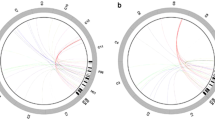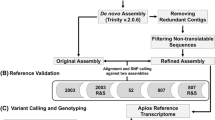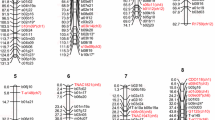Abstract
In plants, gametophytic apomixis is a form of asexual reproduction that leads to the formation of seed-derived offspring that are genetically identical to the mother plant. A common set of RFLP markers, including five rice anchor markers previously shown to be linked to apomixis in Paspalum simplex, were used to detect linkage with apomixis in P. notatum and P. malacophyllum. A comparative map of the region around the apomixis locus was constructed for the three Paspalum species, and compared to the rice map. The locus that controls apomixis in P. simplex was almost completely conserved in the closely related species P. malacophyllum, whereas it was only partially represented in the distantly related species P. notatum. Although strong synteny of markers was noted between this locus and a portion of rice chromosome 12 in both P. simplex and P. malacophyllum, the same locus in P. notatum was localized to a hybrid chromosome which carries markers that map to rice chromosomes 2 and 12. All three Paspalum species showed recombination suppression at the apomixis locus; in the case of P. notatum, this might be due to a heterozygosity for a translocation that most probably negatively interferes with chromosomal pairing near the locus. A common set of markers that show linkage with apomixis in all three Paspalum species define a portion of the apomixis-controlling locus that is likely to contain genes critical for apomictic reproduction.




Similar content being viewed by others
References
Bennett MD, Smith JB (1976) Nuclear DNA amounts in angiosperms. Philos Trans R Soc Lond B 274:227–274
Bennetzen JL (2000) Comparative sequence analysis of plant nuclear genomes: microcolinearity and its many exceptions. Plant Cell 12:1021–1029
Bennetzen JL, Freeling M (1993) Grasses as a single genetic systems: genome composition, colinearity and compatibility. Trends Genet 9:259–261
Bennetzen JL, Ramakrishna W (2002) Numerous small rearrangements of gene content, order and orientation differentiate grass genomes. Plant Mol Biol 48:821–827
Busti A, Caceres ME, Calderini O, Arcioni S, Pupilli F (2004) RFLP markers for cultivar identification in tall fescue ( Festuca arundinacea Schreb.) Genet Res Crop Evol, in press
Caceres ME, Pupilli F, Quarin CL, Arcioni S (1999) Feulgen densitometry of embryo sacs permits discrimination between sexual and apomictic plants in Paspalum simplex. Euphytica 110:161–167
Caceres ME, Pupilli F, Piano E, Arcioni S (2000) RFLP markers are an effective tool for the identification of creeping bentgrass ( Agrostis stolonifera L.) cultivars. Genet Res Crop Evol 47:455–459
Caceres ME, Matzk F, Busti A, Pupilli F, Arcioni S (2001) Apomixis and sexuality in Paspalum simplex: characterization of the mode of reproduction in segregating progenies by different methods. Sex Plant Reprod 14:201–206
Chen M, SanMiguel P, De Oliveira AC, Woo SS, Zhang H, Wing RA, Bennetzen JL (1997) Microcolinearity in Sh2 -homologous regions of the maize, rice and sorghum genomes. Proc Natl Acad Sci USA 94:3431–3435
Daniell H (2002) Molecular strategies for gene containment in transgenic crops. Nat Biotechnol 20:581–586
Feuillet C, Keller B (1999) High gene density is conserved at syntenic loci of small and large grass genomes. Proc Natl Acad Sci USA 96:8665–8670
Feuillet C, Keller B (2002) Comparative genomics in the grass family: molecular characterization of grass genome structure and evolution. Ann Bot 89:3–10
Goel S, Chen Z, Conner JA, Akiyama Y, Hanna WW, Ozias Akins P (2003) Delineation by fluorescence in situ hybridization of a single hemizygous chromosomal region associated with aposporous embryo sac formation in Pennisetum squamulatum and Cenchrus ciliaris. Genetics 163:1069–1082
Goff S, et al (2002) A draft sequence of the rice genome ( Oryza sativa L. ssp. japonica). Science 296:92–100
Grimanelli D, Leblanc O, Espinosa E, Perotti E, Gonzales de Leon D, Savidan Y (1998) Mapping diplosporous apomixis in tetraploid Tripsacum: one gene or several genes? Heredity 80:33–39
Hackett CA, Bradshaw JE, Mayer RC, McNicol, JW, Milbourne D, Waugh R (1998) Linkage analysis in tetraploid species: a simulation study. Genet Res 71:143–154
Harushima Y, et al (1998) A high density rice genetic linkage map with 2275 markers using a single F2 population. Genetics 148:479–494
Kilian A, Chen J, Han F, Steffenson B, Kleinhofs A (1997) Towards map-based cloning of the barley stem rust resistance genes Rpg1 and rpg4 using rice as an intergenomic cloning vehicle. Plant Mol Biol 35:187–195
Labombarda P, Busti A, Caceres ME, Pupilli F, Arcioni S (2002) An AFLP marker tightly linked to apomixis reveals hemizygosity in a portion of the apomixis-controlling locus in Paspalum simplex. Genome 45:513–519
Lander E, Green P, Abrahmson J, Barlow A, Daly M, Lincoln S, Newburg L (1987) MAPMAKER: an interactive computer package for constructing primary genetic linkage maps in experimental and natural populations. Genomics 1:171–181
Lincoln S, Daly M, Lander E (1992) Constructing genetic maps with MAPMAKER/EXP 3.0. Whitehead Institute Technical Report (3rd edn). Whitehead Institute, Cambridge, Mass.
Martinez EJ, Urbani MH, Quarin CL, Ortiz JPA (2001) Inheritance of apospory in bahiagrass, Paspalum notatum. Hereditas 135:19–25
Martinez EJ, Hopp HE, Stein J, Ortiz JPA, Quarin CL (2004) Genetic characterization of apospory in tetraploid Paspalum notatum based on the identification of linked molecular markers. Mol Breeding, in press
Moore G, Aragon-Alcaide L, Roberts M, Reader S, Miller T, Foote T (1997) Are rice chromosomes components of a holocentric chromosome ancestor? Plant Mol Biol 35:17–23
Moore SR, Devos KM, Wang Z, Gale MD (1995) Cereal genome evolution: grasses, line up and form a circle. Curr Biol 7:737–739
Nagamura Y, Antonio BA, Sasaki T (1997) Rice molecular genetic map using RFLPs and its applications. Plant Mol Biol 35:79–87
Nogler GA (1984) Gametophytic apomixis. In: Johri EM (ed) Embryology of angiosperms. Springer Verlag, Berlin pp 475–518
Ortiz JPA, Pessino S, Leblanc O, Hayward MD, Quarin CL (1997) Genetic fingerprinting for determining the mode of reproduction in Paspalum notatum: a subtropical apomictic forage grass. Theor Appl Genet 95:850–856
Ozias-Akins P, Roche D, Hanna WW (1998) Tight clustering and hemizygosity of apomixis-linked markers in Pennisetum squamulatum implies genetic control of apospory by a divergent locus that may have no allelic form in sexual genotypes. Proc Natl Acad Sci USA 95:5127–5132
Pichot C, El Maataoui M, Raddi S, Raddi P (2001) Surrogate mother for endangered Cupressus. Nature 412:39
Pupilli F, Labombarda P, Caceres ME, Quarin CL, Arcioni S (2001) The chromosome segment related to apomixis in Paspalum simplex is homoeologous to the telomeric region of the long arm of rice chromosome 12. Mol Breeding 8:53–61
Quarin CL (1992) The nature of apomixis and its origin in Panicoideae grasses. Apomixis Newslett 5:7–15
Quarin CL (1999) Effect of pollen source and pollen ploidy on endosperm formation and seed set in pseudogamous apomictic Paspalum notatum. Sex Plant Reprod 11:331–335
Ramulu KS, Sharma VK, Naumova TN, Dijkhuis P, van Lookeren Campagne MM (1999) Apomixis for crop improvement. Protoplasma 208:196–205
Song R, Llaca V, Messing J (2002) Mosaic organization of orthologous sequences in grass genomes. Genome Res 12:1459–1555
Tarchini R, Biddle P, Wineland R, Tingey S, Rafalski A (2000) The complete sequence of 340 kb of DNA around the rice Adh1-Adh2 region reveals interrupted colinearity with maize chromosome 4. Plant Cell 12:381–391
Tikhonov AP, SanMiguel PJ, Nakajima Y, Gorenstein NM, Bennetzen JF, Avramova Z (1999) Colinearity and its exceptions in orthologous adh regions of maize and sorghum. Proc Natl Acad Sci USA 96:7409–7414
Van Deynze AE, Sorrels ME, Park WD, Ayres NM, Fu H, Cartinhour SW, Paul E, McCouch SR (1998) Anchor probes for comparative mapping of grass genera. Theor Appl Genet 97:356–369
Vielle-Calzada JP, Crane CF, Stelly DM (1996) Apomixis: the asexual revolution. Science 274:1322–1323
Yu J, et al (2002) A draft sequence of the rice genome ( Oryza sativa L. ssp. indica). Science 296:79–92
Acknowledgements
This study was carried out within the framework of the Bilateral Agreement (2002–2003) MAE-SETCIP for Italian and Argentinian Research Institutions [Project No. 24(44B)]. The research was supported by the EC project Apotool (Contract No. GLG-CT-2000-0063). We thank Dr. T. Sasaki, the Japanese Rice Genome Research Program of the National Institute of Agrobiological Resources (NIAR), and the Institute of the Society of Techno-Innovation in Agriculture, Forestry and Fisheries (STAFF), Kannondai, Tsukuba, Japan for providing the rice clones, and Dr. S. McCouch of Cornell University (Ithaca, N.Y.) for the oat probe. The work was carried out in compliance with the current laws governing genetic experimentation in Italy and Argentina. This is Contribution No. 31 from the Institute of Plant Genetics-CNR, Research Division of Perugia
Author information
Authors and Affiliations
Corresponding author
Additional information
Communicated by R. Hagemann
Rights and permissions
About this article
Cite this article
Pupilli, F., Martinez, E.J., Busti, A. et al. Comparative mapping reveals partial conservation of synteny at the apomixis locus in Paspalum spp. . Mol Genet Genomics 270, 539–548 (2004). https://doi.org/10.1007/s00438-003-0949-5
Received:
Accepted:
Published:
Issue Date:
DOI: https://doi.org/10.1007/s00438-003-0949-5




